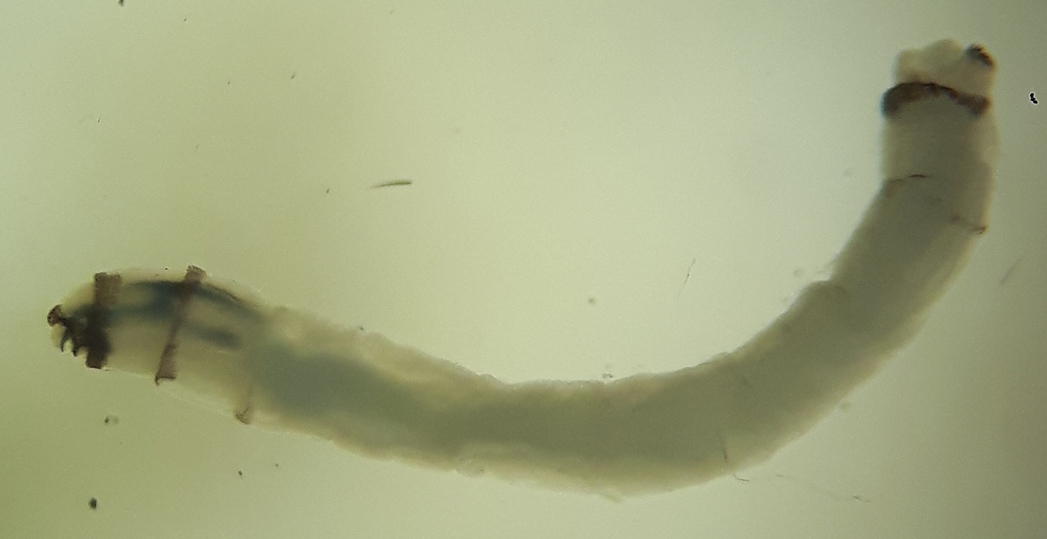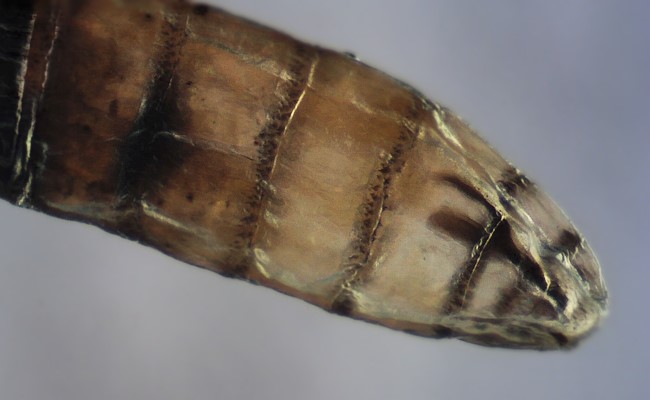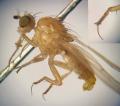Diptera.info :: Identification queries :: Diptera (eggs, larvae, pupae)
|
Small fly larva
|
|
| Paul Beuk |
Posted on 18-09-2018 18:42
|
|
Super Administrator Location: Netherlands Posts: 19403 Joined: 11.05.04 |
Found in Malaise trap sample, July-August, southern Netherlands, 3 mm
Paul Beuk attached the following image:  [255.09Kb] Edited by Paul Beuk on 18-09-2018 18:58 Paul - - - - Paul Beuk on https://diptera.info |
| atylotus |
Posted on 19-09-2018 08:56
|
|
Member Location: Amsterdam, NL Posts: 1166 Joined: 29.05.09 |
Dear Paul I have no idea. Without a closer look of the anterior and posterior spiracles it is impossible (for me) to tell which family. I'm only guessing Drosophilidae for the anterior spiracles seems very anterior, almost lateral of first thoracic segment. The circular rings of brown spicules at the second and third thoracic segment and first and penultimate abdominal segment is strange and must be typical. If you like you can send it to me, but I think family level would be the highest level for me. |
|
|
|
| Tony Irwin |
Posted on 19-09-2018 09:06
|
|
Member Location: Norwich, England Posts: 7320 Joined: 19.11.04 |
As a rule, first instar larvae in a malaise trap have been deposited by a gravid female, so I check out which larviparous species are present and whether any of them are gravid females - often there is one with an emerging larva that can be compared to the "free" larvae in the sample.
Tony ---------- Tony Irwin |
|
|
|
| Paul Beuk |
Posted on 19-09-2018 13:29
|
|
Super Administrator Location: Netherlands Posts: 19403 Joined: 11.05.04 |
Ah, yes, Tony, I very much see your point and I am well familiar with larvae that are likely there because of the larviparous species. Generally those will be Calliphoridae or perhaps Sarcophagidae, but these have rings of spicules on most body segments, rather than just a few segments near the thoracic region and a single ring at the posterior end. Exactly that what Ton remarked ('must be typical') was why I picked it out in the first place and decided to post it here. I will check another few books at the office and then see if I will send it of to Ton. Both thanks for your reply. Edited by Paul Beuk on 19-09-2018 13:30 Paul - - - - Paul Beuk on https://diptera.info |
| johnes81 |
Posted on 19-09-2018 14:29
|
|
Member Location: Berlin, Germany Posts: 1980 Joined: 15.10.16 |
adding a photo of mine to illustrate the general appearance of the larvae of Calliphoridae. The photo depicts a larva of Onesia. I want to add that the larvae of Calliphoridae are generally more robust but i've not seen all of the larvae. Anyway, interesting post. please let us know what it is when you discover its identity. johnes81 attached the following image:  [38.5Kb] John and Nini. Naturalists not experts. |
|
|
|
| Daniel Whitmore |
Posted on 14-07-2020 20:35
|
|
Member Location: Stuttgart, Germany Posts: 97 Joined: 09.07.10 |
Looks like a first instar of Sarcophaga (Heteronychia) filia or related species
Daniel |
|
|
|
| Jump to Forum: |













